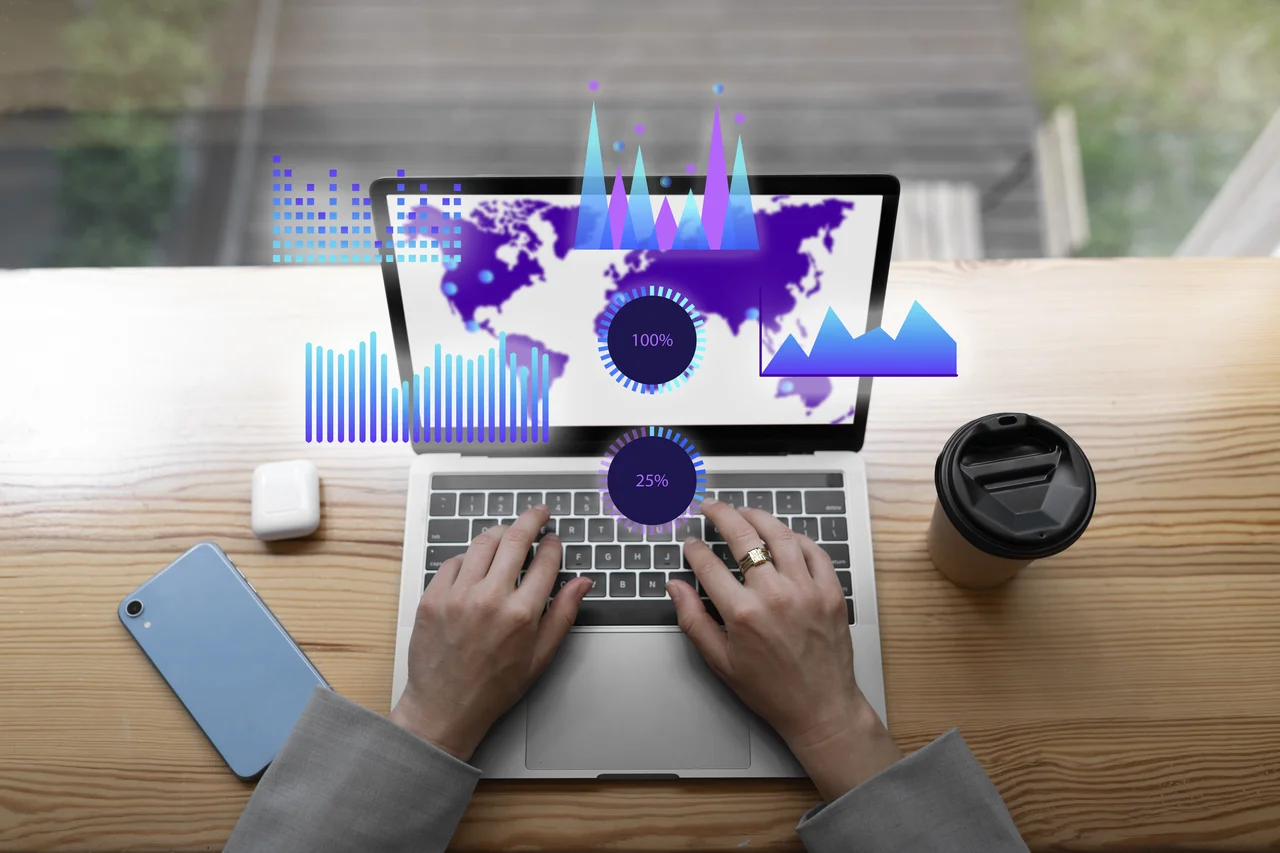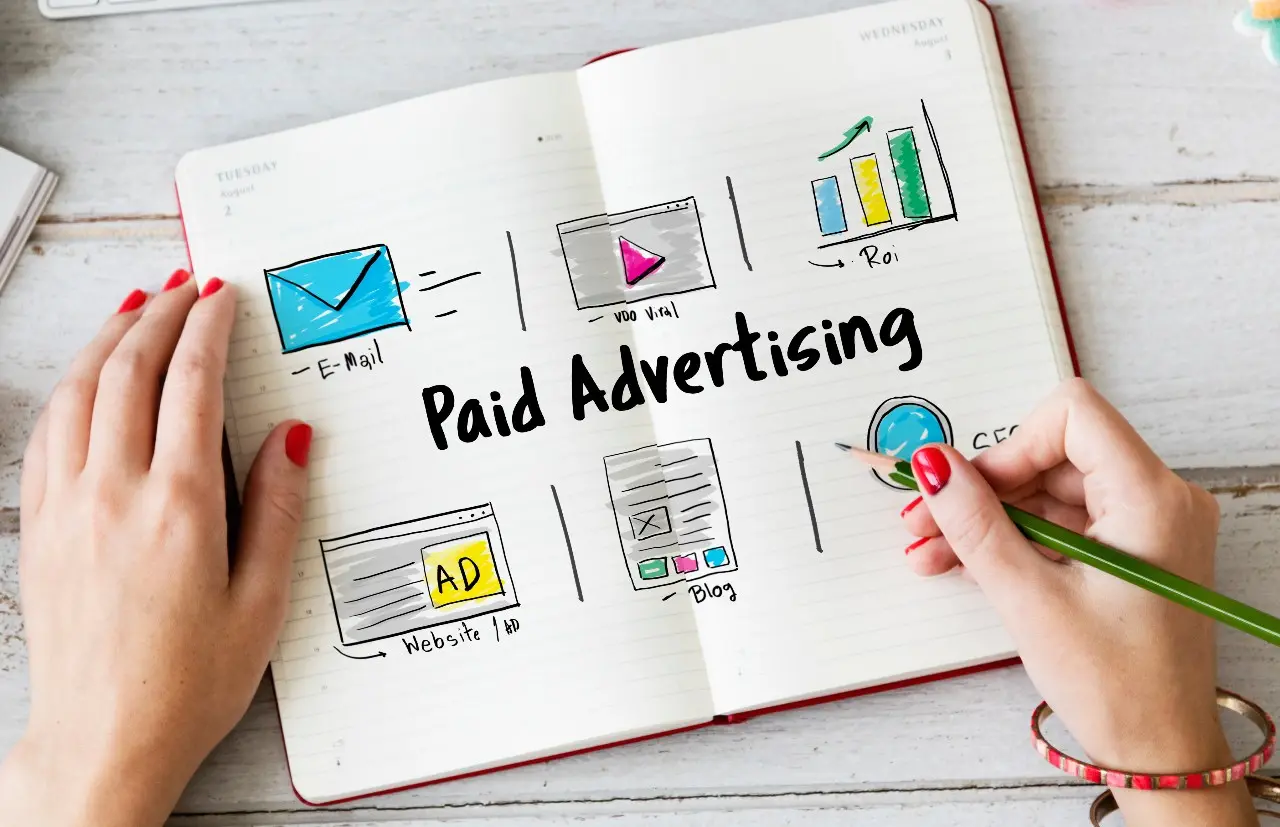Listen to article
“Are you ready to take a peek into the future of marketing?” As we advance towards 2025, the marketing landscape is rapidly changing, driven by new technologies, evolving consumer behaviors, and an increasing emphasis on data-driven strategies. For B2B marketers, staying ahead means understanding the key trends and statistics that will shape the industry.
This article dives into the essential marketing analytics statistics B2B marketers need to know to optimize their campaigns, demonstrate ROI, and drive revenue growth. From the rise of AI and the importance of first-party data to social media advertising spend and the power of integrated marketing strategies, we’ll cover the numbers that matter most.
The Role of AI in Shaping the Future of B2B Marketing Analytics
Artificial intelligence is no longer a nice-to-have in the world of B2B marketing—it’s becoming the backbone of data-driven strategies that deliver measurable outcomes. From understanding customer behavior to automating complex campaigns, AI is revolutionizing how marketers approach their goals. Forward-thinking organizations are prioritizing AI integration not just to stay ahead, but to redefine what success looks like in a hyper-competitive space. Here are some eye-opening statistics that reveal just how deeply AI is transforming B2B marketing analytics:
- Currently, half of B2B marketing leaders are leveraging AI in their strategies. Source
- A significant 75% of B2B marketers are considering adopting generative AI to enhance their business promotion efforts, indicating a strong future trend in AI-driven advertising. Source
- Companies that lead in B2B revenue are 2 to 6 times more likely to have in-house marketing functions such as data science and analytics, marketing automation, and account-based marketing. Source
- Google Ads utilizes AI to enhance various aspects of advertising, including bid optimization and ad creation, to improve audience targeting. Source
- Google’s Performance Max campaigns employ key wordless AI to identify new converting queries and generate ads that align with user intent, and also allow for the rapid creation and scaling of creative assets. Source
- Microsoft provides generative AI ad features, including Conversational Ad experiences, Ads for Chat API, and Copilot, to enhance advertising capabilities. Source
Takeaway: AI is Non-Negotiable for Competitive Advantage
The widespread adoption of AI in B2B marketing is not just a passing trend; it’s a seismic shift that’s setting a new benchmark for success. From generative AI tools that streamline creative development to advanced platforms that optimize ad spend in real-time, leveraging AI is no longer a futuristic concept—it’s an immediate necessity. Marketers who fail to embrace AI risk falling behind, especially as leaders in revenue growth continue to build robust in-house capabilities in data science, marketing automation, and analytics-driven decision-making.
Pro Tip:
If AI still feels like uncharted territory, start by aligning AI capabilities with your current pain points. For example, use tools like Google’s Performance Max or Microsoft Copilot to enhance campaign targeting, or explore generative AI for efficient content creation. By building confidence in specific areas, you’ll be better prepared to scale AI across your marketing strategy.
Bridging the Disconnect in Marketing Analytics and Data Utilization
In an era where data reigns supreme, businesses find themselves grappling with a persistent challenge: turning their vast amounts of data into actionable insights. While organizations invest heavily in marketing technology, many are still unable to bridge the analytics gap or fully integrate their data into decision-making processes. This disconnect not only limits the potential of marketing campaigns but also makes it difficult to accurately measure ROI or demonstrate value to stakeholders.
- A significant 44% of businesses lack a quantitative understanding of their marketing’s impact, showcasing just how critical it is to develop better measurement frameworks. Source
- Despite its value, 87% of marketers agree that data remains the most underutilized asset in their organizations. Source
- Only 25% of marketers have successfully integrated their marketing data with the tools they use—hindering their ability to craft cohesive strategies. Source
- Surprisingly, 70% of marketers confirm they have the technology needed to measure activities, signalling a disconnect between having tools and effectively using them. Source
- Encouragingly, 82% of marketers claim they have sufficient data to demonstrate their impact to leadership, revealing a need to better harness these resources. Source
The time to address this analytics gap is now. As marketing continues to evolve into a data-heavy discipline, those who fail to integrate, manage, and exploit their data risk falling behind competitors who do. Beyond simply collecting data, it’s about creating systems that make this information work for you—whether that’s through automating workflows, enriching customer insights, or fine-tuning attribution models.
Pro Tip:
Equip your team with robust data integration platforms like Segment, Snowflake, or Zapier to ensure seamless connectivity between marketing tools. Combine this with regular upskilling opportunities for your team in data science and analytics to empower them to transform raw numbers into strategic gold. A culture of continuous improvement and collaboration between marketing and data teams will set the foundation for long-term success.
The Rise of Social Media and Video in Ad Strategies
Social media and video marketing have emerged as the powerhouses of modern-day advertising, seamlessly blending consumer engagement with brand messaging. As ad budgets increasingly shift toward these channels, brands are finding new opportunities to connect with audiences in authentic, dynamic ways. For marketers aiming to stay ahead, mastering the data-backed growth of these mediums is no longer optional—it’s imperative to remain competitive in a crowded digital landscape.
- Total ad spend on social media is projected to reach $220 billion in 2024. Source
- Social media advertising accounts for an average of 28.8% of all ad spending. Source
- A staggering 94% of video marketers consider video an essential part of their overall strategy. Source
- 86% of businesses are currently leveraging video as a marketing tool. Source
- Nearly every marketer (99%) plans to continue using video within their strategies moving forward. Source
- Live video is gaining traction, with 46% of marketers actively using it as part of their social media tactics. Source
- 96% of marketers have allocated budget specifically for video advertising. Source
- Over 70% of businesses report creating more video content compared to last year, pointing to a substantial increase in video investments. Source
- Short-form videos (under 90 seconds) retain 50% of viewers, making them a key asset for social media and video ad campaigns. Source
- Cisco projects that online videos will account for more than 82% of consumer internet traffic. Source
Takeaway: Leverage Video and Social Media as Growth Catalysts
It’s clear that video and social media are no longer supporting players—they are driving forces in today’s advertising landscape. The projected ad spend and consumption rates reflect a consumer base increasingly reliant on visually engaging, concise, and interactive content. To stand out, brands must not just participate in these spaces but excel, prioritizing strategy, creativity, and analytics to craft campaigns that resonate. From the surge in live-streaming adoption to the proven effectiveness of short-form video formats, these trends reveal one key truth: the brands that invest in innovative, audience-focused video campaigns will outpace their competition.
Pro Tip:
Consistency matters as much as creativity. Develop a cohesive multi-channel strategy by tailoring each video to the platform it’s on. Use Instagram Reels or TikToks for short, entertaining clips, while platforms like YouTube are ideal for long-form storytelling. Incorporate analytics tools to track engagement patterns and refine your approach in real time.
Email Marketing and Automation: The Core of High-ROI Strategies
As marketing budgets face increasing scrutiny, understanding where to allocate resources for maximum impact has never been more critical. Among all available channels, email marketing continues to dominate for ROI, and marketing automation has become the secret weapon for scaling personalized outreach and boosting efficiency. These tools aren’t just nice-to-haves; they are pivotal for businesses looking to stay competitive in today’s increasingly data-driven marketing landscape. Let’s dive into the numbers that highlight just how impactful these strategies can be.
- Email marketing consistently boasts one of the highest ROIs among marketing channels, outperforming SEO, mobile marketing, and content marketing. Source
- The global email user base is projected to reach 4.6 billion by 2025, up from 4 billion in 2020—highlighting email’s growing audience potential. Source
- For lead generation, email marketing is more than twice as effective as paid advertising, with 59% of marketers confirming its superior performance. Source
- Global email marketing revenue is expected to soar to $13.69 billion by 2025, nearly doubling from $7.5 billion in 2020. Source
- Half of US B2B marketers rank email marketing as the most impactful channel in their multichannel strategies, emphasizing its role in B2B success. Source
- Automated email workflows can boost lead generation by 20%, proving the power of automation in driving conversions. Source
- 65% of marketers report having a successful marketing automation strategy, showcasing the effectiveness of well-executed automation. Source
Takeaway: Optimize for Engagement and Efficiency
The data is clear: Email marketing isn’t just surviving; it’s thriving. As we move toward 2025, the convergence of growing email usage, rising revenues, and advancements in automation tools has made email a cornerstone of any high-performing marketing strategy. But with so much opportunity comes the need for sharp execution. The most successful marketers are those who go beyond sending generic campaigns. Instead, they leverage segmented lists, dynamic personalization, and automated workflows to meet customers where they are—and drive meaningful results.
Pro Tip:
Don’t get complacent. The competitive edge lies in continually refining your strategy. Experiment with A/B testing subject lines and email formats to enhance open rates, and use behavioral triggers to create hyper-relevant workflows. Tools like HubSpot, ActiveCampaign, and Mailchimp can help you take automation and email personalization to the next level.
Mastering Ad Targeting in a Cookieless Era: The Power of First-Party Data
As the advertising world braces for a cookieless future, first-party data is emerging as the cornerstone of effective ad targeting. Unlike third-party cookies, which are increasingly restricted by regulations and browser changes, first-party data allows brands to build authentic, consumer-driven insights. This shift isn’t just a technical adjustment—it represents a fundamental transformation in how marketers connect with audiences and drive campaign success.
- Many marketers are prioritizing first-party data collection, gathering information directly from consumers through surveys, customer insights, and analytics tools, reducing their reliance on third-party tracking. Source
- Despite Google’s initial pause on deprecating third-party cookies, the phase-out is still imminent, with the tech giant transitioning to a consent-based cookie model that puts more control into consumers’ hands. Source
- The end of third-party cookies has heightened the importance of first-party data, content marketing, and email marketing. Brands embracing responsible data use and transparency are maintaining stronger customer loyalty and trust. Source
- Yet, 75% of marketers still depend on third-party cookies, signaling a lag in adoption of first-party strategies. Source
- First-party data is becoming essential for driving higher-quality leads in a highly competitive ad landscape. Source, Source, Source
- Google’s enhanced conversions feature already leverages first-party data to improve bidding precision and accuracy. Source, Source, Source
- Performance Max campaigns now allow advertisers to use first-party data as audience signals, resulting in better bidding strategies and more effective targeting. Source, Source, Source
- High-quality first-party data also amplifies the effectiveness of Lookalike Audiences for targeted social media campaigns. Source
Takeaway: Make Data Ownership Your Competitive Advantage
The push toward first-party data is more than a technological shift—it’s a competitive imperative in today’s privacy-conscious marketing environment. Brands that can effectively harness their own customer insights will not only navigate the decline of third-party cookies but also outperform competitors still clinging to outdated methods. With tools like enhanced conversions and audience signals, first-party data provides unmatched opportunities to fine-tune your targeting and enhance customer experiences.
Pro Tip:
Start building your first-party data strategy today. Incorporate mechanisms like opt-in surveys, loyalty programs, and CRM integrations to collect high-quality data. Then, leverage platforms like Google’s enhanced conversions or Performance Max to turn those insights into actionable, high-impact campaigns.
Paid Advertising Insights: Budget Priorities, Campaign Oversight, and Effective Channels
Staying ahead in the competitive world of paid advertising requires more than just increasing budgets—it calls for strategic management and smarter investments. With advertising spend climbing across industries, the real differentiator lies in how effectively marketers monitor and optimize their campaigns. A deep understanding of budget shifts, channel performance, and the importance of regular oversight can prevent wasted ad spend and drive meaningful results.
- 62% of marketing teams increased their PPC budgets in the past year. Source
- A significant 72% of companies have not reviewed their ad campaigns in over a month, leading to potential wasted ad spend. Source
- Facebook and Google ads are identified as the paid advertising channels with the highest ROI. Source
In the current landscape, increasing ad spend without a robust tracking and optimization strategy is like pouring water into a leaky bucket. Rising budgets indicate confidence in the power of PPC, but the fact that nearly three-quarters of companies fail to review their campaigns regularly suggests that many businesses are leaving money on the table. High-performing platforms like Facebook and Google Ads should remain a cornerstone of any paid strategy, but consistent monitoring is critical to sustaining high ROI.
For businesses looking to refine their digital advertising while juggling other marketing priorities, partnering with a full-service marketing agency can help streamline processes and maximize returns. This approach ensures that every aspect of your marketing strategy, from ad management to content creation, is professionally handled.
Pro Tip:
Establish a bi-weekly or monthly review schedule for your ad campaigns. Use these sessions not only to cut underperforming ads but also to experiment with new audiences, ad formats, or messaging to uncover untapped opportunities. Tools like Google Ads Performance Planner or Facebook Ads Manager can streamline this process.
The Role of LinkedIn Ads, Conversational AI, and Integrated Strategies in Marketing Success
As the marketing landscape grows more data-driven, leveraging the right tools and strategies to connect with audiences has never been more critical. From LinkedIn’s rising dominance in the B2B advertising space to the adoption of conversational AI, brands that embrace innovation are positioning themselves as leaders in their industries. Meanwhile, integrated marketing strategies are proving invaluable for delivering cohesive messaging and achieving measurable outcomes. Below are some of the standout statistics driving these trends—and what they mean for marketers aiming to stay ahead of the curve.
- LinkedIn ad revenues are projected to grow by 12.7% in 2025, reaching $5.09 billion, with B2B display ad revenues increasing by 12.5% to $4.73 billion. Source, Source
- 26% of B2B marketers in the United States who implemented chatbots into their marketing strategies experienced a 10-20% increase in lead generation volumes. Source
- Integrating your marketing team and channels can lead to a 31% increase in campaign efficiency. Source
- Campaigns that use an integrated approach see an average of 50% more return on investment (ROI). Source
- TikTok users show a high openness to advertisements, with 38% being receptive to ads, compared to only 4% of general internet users. Source
- A significant portion of marketing leaders, more than one-third, consider conversion rates as their primary KPI. Source
Takeaway: Marketing Innovation Is Essential for Competitive Edge
The numbers speak for themselves: embracing modern tools like LinkedIn’s robust ad platform, conversational AI, and integrated strategies is no longer optional—it’s a necessity. LinkedIn’s revenue projections highlight its importance in B2B advertising, while the growing effectiveness of chatbots proves that conversational AI is reshaping how brands engage with prospects. Integrated approaches, by breaking down silos across teams and channels, are delivering unmatched ROI and efficiency.
Emerging platforms like TikTok also hold potential for brands willing to experiment with creative ad formats, particularly given the platform’s high audience receptivity. However, success in these areas hinges on setting the right metrics—conversion rates, for example—to ensure your efforts remain aligned with your marketing goals.
Pro Tip:
Prioritize tools that help you unify your marketing efforts—whether that’s AI-powered chatbots, collaboration platforms, or advanced analytics tools. LinkedIn, in particular, is poised to deliver strong B2B results, but don’t underestimate the value of creating an integrated strategy that adapts to different platforms like TikTok for consumer audiences. For small and medium-sized enterprises, incorporating digital marketing strategies for small businesses can help drive growth while maintaining a manageable and cost-effective approach. Finally, revisit your KPIs quarterly to measure progress and recalibrate as needed, ensuring actionable insights fuel your future growth.
Conclusion
As we look toward 2025, one thing is clear: marketing analytics is no longer just a nice-to-have—it’s a must-have for businesses aiming to thrive in an increasingly competitive landscape. From the rise of AI in B2B marketing to the critical shift toward first-party data and the growing dominance of video and social media advertising, these statistics tell a story of transformation, innovation, and opportunity. Businesses that embrace these trends stand to gain a significant competitive edge, whether through enhanced targeting, better ROI, or more effective campaign execution.
But leveraging these insights requires action. Are your marketing strategies prepared to harness the power of AI? Is your data integrated and optimized for informed decision-making? Are you adapting to new advertising trends and prioritizing ROI-driven channels? Each of these areas presents a chance to refine and elevate your approach in line with future industry demands.
If you’re ready to supercharge your business, don’t hesitate to get in touch with our full-service marketing pros for a free quote. Let us help you turn these insights into impactful strategies that drive growth and long-term success.
About Creating the Marketing Analytics Key Statistics Article
This article was written by the Scopic Studios team and reviewed by Araksya Hakobjanyan, SEO Lead at Scopic Studios.
Scopic Studios delivers exceptional and engaging content rooted in our expertise across marketing and creative services. Our team of talented writers and digital experts excel in transforming intricate concepts into captivating narratives tailored for diverse industries. We’re passionate about crafting content that not only resonates but also drives value across all digital platforms.
Note: This feature blog’s image are sourced from Freepik.

































































































































































































































































